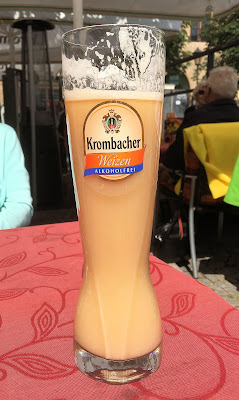 |
| Albrecht von Brandenburg by Albrecht Dürer |
It was not Martin Luther who triggered the Reformation but Albrecht, brother of Joachim, the elector of Brandenburg. In 1513 Albrecht von Brandenburg was elected archbishop of Magdeburg at the tender age of 23, but he preferred to reside in his beloved Halle. The name Halle is of Celtic origin, meaning salt. The river Saale flowing through the town recalls the Germanic word salt too.
In the Middle Ages, the Pfänner of Halle operated evaporating pans to extract precious salt from brine, thereby becoming the town's rich people. They proudly called themselves Halloren, while the other inhabitants were known as Hallenser. Today the Hallorentorte, rich in calories, reminds the visitor of those ruling pan holders.
 |
| Billions of calories in Hallorentorte |
 |
| In 1500 from left to right: Gertraudenkirche, Marienkirche, and Roter Turm |
Ultimately they kept the two church towers of St. Mary's Church, so today's Market Church has four steeples.
 |
| Present view of Halle's center looking on Marktkirche and on the Red Tower lacking its original color. |
 |
| Luther's relief at Marktkirche |
Let us return to Reformation history and Albrecht's story, who ambitiously wanted to surpass his older brother. When 1514, the bishopric of Mainz became vacant, Albrecht applied for the job. Although the members of the cathedral chapter were not averse to the noble candidate, they refused to collect the pallia money to be paid to the pope for a new bishop in their diocese. To ensure his election, Albrecht himself procured the required 14,000 guilders and sent them to Rome.
As Archbishop of Mainz, Albrecht was one of the three clerical electors and had as primo inter pares the position of Archicancellarius per Germaniam, i.e., chancellor of the German-speaking parts of the Reich. In contrast, his brother Joachim only held the symbolic function of Archicamerarius (Erzkämmerer, i.e., arch-chamberlain).
All had worked out fine for Albrecht except for the problem of simony. In fact, the Church Councils of Chalcedon in 451 and Nicaea in 787 had forbidden the purchase of clerical posts and positions. However, money will buy anything almost. So after having paid another 10,000 guilders to Pope Leo X, Albrecht got a dispensation from the pontiff.
Where did Albrecht's money come from? The sums involved in 1514 were peanuts for the Fuggers in Augsburg compared to the 851,918 guilders* they would shell out 1519 to Charles V, who would bribe his electors. Jacob the Rich lent relatively moderate sums to Albrecht against interest, making it hard for the archbishop to pay his debts. Eventually, Pope Leo had a brilliant idea. For the new construction of St. Peter in Rome, he needed lots of money and had therefore issued an indulgence. Why shouldn't Albrecht sell these indulgence papers in his bishoprics? Thanks to Gutenberg's invention, these papers were printed en masse in the basements of the Vatican. By selling indulgences in his dioceses, Albrecht would get part of the money he could use to pay the Fuggers.
*equivalent to 120 million US$
When Martin Luther noticed that poor people hurried to buy these indulgence papers with what little money they had he blew up and wrote to Albrecht: Ablaß ist lauter Büberei und Trügerei, die die armen, einfältigen Christen um Geld und Seele bringet. Darum sei E.K.F.G.* endlich und schriftlich angesagt: wo nicht der Abgott wird abgetan, muß ich ... E.K.F.G. wie den Papst öffentlich an[zu]tasten ... allen vorigen Greuel des Tetzel* auf den Bischof von Mainz treiben und aller Welt anzeigen den Unterschied zwischen einem Bischof und einem Wolfe (Indulgence is nothing else than knavery and cheating that tricks poor, simple-minded Christians out of their money and souls. Therefore E.K.F.G. be finally told and here in writing: If the idol is not abjured, I must publicly finger ... E.K.F.G. as well as the Pope ... and attribute all previous horrors by Tetzel to the bishop of Mainz showing all the world the difference between a bishop and a wolf).
*Euer kurfürstliche Gnaden (Your Grace the Electoral Prince). Tetzel was the most (in)famous indulgence preacher of his time.
When His Grace Archbishop Albrecht failed to react to the letter of an Augustinian monk, he was mistaken for Luther did not hesitate to make his famous 95 theses public, the act that started the Reformation.
 |
| Luther posts his 95 theses as it is imagined in the States. |
 |
| The New Residence was started in 1531 |
 |
| View toward the altar. |
 |
| Albrecht among saints from left to right: Mary Magdalene, John the Apostle, Archbishop Albrecht, and Catherine of Alexandria |
Here is the monument of Halle's greatest son, Georg Friedrich Händel, at the Marketplace.
This was nearly the end of my trip to Lutherland. On our way back to Freiburg, we passed the Völkerschlachtdenkmal ...
 |
| Epitaph at the Orthodox church St. Andrej commemorating the many Russians killed in the Battle of Nations. Note that the Prussians had the highest death toll, with 22%. |
...and made a stop at Jena to have a look at Luther's epitaph.
 |
| Entrance to St. Michael, home of Luther's epitaph |
 |
| Elector John Frederick, the Magnanimous of Saxony, Founder of Jena's University |
Are those people living on the territory of the former GDR still obsessed with bananas? Rumors have it that - following the opening of the wall in 1989 - the first thing people visiting the West were looking for was:
A beautiful bunch o' ripe banana
Daylight come, and me wan' go home
Hide the deadly black tarantula
Daylight come, and me wan' go home.
I also wanted to go home because I feared the tarantula, and was full of indigestible Bananenweizen.
*
*





No comments:
Post a Comment